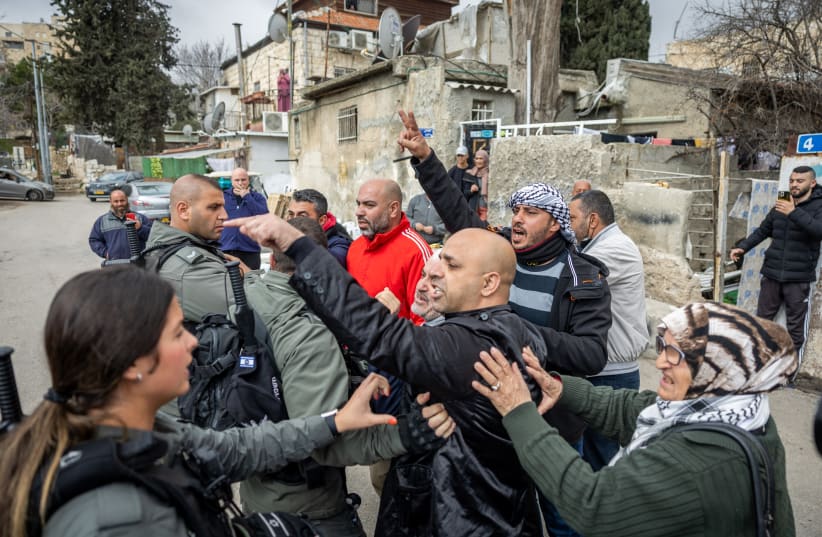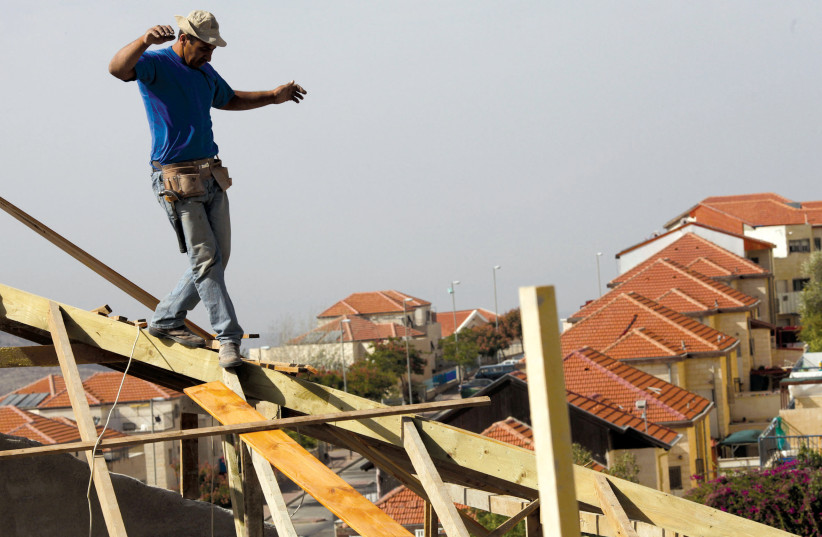“The Judaization of Jerusalem is an attempt to find a unifying Jewish identity,” declared a Sheikh Jarrah resident last week, during one of the many protests held there against the Jewish presence and expulsion of residents by court rule.
Whether the recent – and recurring – events of this neighborhood point at a Jewish attempt to take over and Judaize the city, or if it’s Palestinian exploitation of local problems for international exposure, there is no doubt that the relatively prestigious neighborhood has in recent years become the flagship of the political struggles tearing apart Arab society in the capital’s east side.
Abdullah Maruf, a researcher on Jerusalem affairs, adds that although “the occupation has dominated the eastern part of the city for more than 50 years and has been trying to make it a Jewish symbol, it still has an Arab, Muslim and Christian character.”
It took indeed just a few sparks for the combustible situation in Sheikh Jarrah to blow up. Since May, international attention has been focused on Palestinian protests against housing dispossessions and the police response in that small neighborhood, and the presence of Israeli politicians has only added to the explosive situation already existing.
But is Sheikh Jarrah – with its Arab residents and the brouhaha circling it, and its associated Israelis activists from the radical Left and far Right – the whole story of the 370,000 Arab residents of Jerusalem?
IN 1970, the Knesset passed a law that allowed Jews who had lost property in east Jerusalem in 1948 to reclaim it, but the Palestinians were not granted reciprocal rights. As a result, dozens of eviction lawsuits concerning properties in east Jerusalem, in process for decades, began to hit the courts in 2020, raising high concern among thousands of Arabs residents.
This led to rising tensions, mostly centered around Sheikh Jarrah, Silwan, the Muslim Quarter and Beit Hanina. But behind this stands an unofficial political status between Israel and the Palestinian Authority, which results in the fact the PA does not interfere in cases of demolitions or expulsions, leaving the Arab Jerusalemites with a sense of abandonment.
That was the case of Habeeb, a Beit Hanina resident who built a three-story house for himself, his two brothers and his parents on a plot he purchased from another Arab resident. A couple of years after the house was completed, the municipality informed him the land belonged to someone else, and that the entire structure was illegal and must be demolished.
Habeeb, in his naïve understanding (as he characterized it), turned to PA representatives in hopes they would help him prevent the decree. To his amazement, the answer he received was, “Deal with it by yourself, we do not interfere.”
Habeeb is not alone: “We are torn between the Israelis and us. We have no support from the PA and we have to manage on our own. Whoever understands this, acts in that direction. There are those who still believe that change will come and the PA will rule Jerusalem.
“I know it’s not going to happen, so I’m trying to get by. And there are many more like me,” he concludes, admitting he holds Israeli citizenship and works in the city’s western part.
FOR AVI (not his real name), a high-ranking official at Safra Square whose job is tightly linked to the daily life of Arab residents of the Holy Basin of the city, making Sheikh Jarrah the focal point of Jerusalem’s Arabs is far from the reality on the ground.
“The majority of the Arabs in Jerusalem are preoccupied with a long list of issues, such as education, employment, the coronavirus, security and so on. Sheikh Jarrah has become a symbol, but this is not part of their daily life, which is still far from being easy, despite significant improvements provided by the Israeli authorities.”
Avi added that for residents of neighborhoods far from there, daily and tough realities of their life are much more important.
Today, while fears remain of being evicted or expelled, the young generation faces quite different issues.
In east Jerusalem, a large number of schools run according to the Tawjihi curriculum, the Palestinian program that parallels the Israeli bagrut (matriculation exams). While this is still the majority’s choice, more and more young people are finally deciding to take the Israeli bagrut – the only one that will allow them to learn Hebrew, an asset that will later open the gates to Israeli universities and colleges.
“When a Palestinian student graduates from high school, he faces a crossroads, and begins to ask himself – should he go to study at an Israeli university? Or choose a Palestinian university? What are the disadvantages and what are the advantages in each of the options?” ask Arabs on the 0202 site, which brings testimonies of those who have chosen one or the other option.
It turns out that even those who went to Palestinian universities admit that once they graduate, they still have to learn Hebrew in order to find a decent job, which can mostly be found on the west side.
In 2019, Arab students constituted 13% of the total number of students in the academic institutions of Jerusalem. Between 2014 and 2019, there was a 182% increase in the number of Arab students in the academic institutions in Jerusalem (based on Palestinian data sources).
“There is a difference between teenagers still studying in high schools and graduates who reach the point they have to decide about their future,” continues Avi.
“While teenagers are less exposed to the Israelis, except for Border Police, graduates face more serious situations; like studying Hebrew or not. Should they study in a Palestinian university, or renounce what could be felt as part of their identity but something that will not really benefit them later on at the stage when they will look for a job on the west side?”
Arab students of Jerusalem also add that besides the practical aspect – like lack of Hebrew knowledge – there are many fears that they will not be accepted, that they will meet Jewish-Israeli students who might threaten them on political grounds.
“I wear a hijab,” says Amina, a student at the Hebrew University. “Some of the teachers are nice and patient with me, others obviously don’t like to see me, a Muslim woman in their class. But I have decided I want to get an education at the highest level – so I manage, and my family backs me.”
In parallel, many Arab students at the Hebrew University mingle nicely and get along, since the university is generally regarded as somewhat of a model for coexistence.
THE CORONAVIRUS also caused substantial damage in the eastern part of the city. Only a small number of people were tested in the first weeks, with many other patients not being identified and not being treated, all the while living in dense, and dangerous, neighborhoods.
Part of the problem was a natural suspicion of everything that came from the Israeli authorities – the “occupation.”
But part of it stemmed from other difficulties. Too few people were tested because of a negative social stigma associated with the virus, due to a lack of awareness of the illness and how it spreads. When calling the national medical hotline (MDA), they could not get Arabic-speaking responders. And last but not least, symptomatic people still visited public health clinics and may have infected others.
Yet the municipality recovered fairly quickly and dealt with all these difficulties. But it took time.
In response to the large number of employees who were sent home on a leave of absence, and their struggle to understand their rights amid the bureaucracy, the Labor Ministry in collaboration with the Jerusalem Affairs and Heritage Ministry, led an initiative to assist east Jerusalem residents in filling out forms and submitting them to the Employment Service. The volunteers providing assistance were students of the AlBashair program, which promotes outstanding students from the east side and prepares them to enter the Hebrew University. (This is part of the five-year program for the economic development of east Jerusalem, officially known as 3790.)
YET ARAB residents have to face many additional challenges unknown by their neighbors on the west side, such as their electricity bills.
East Jerusalem residents do not receive their electricity from the Israel Electric Corporation but through the Jerusalem District Electricity Company (JDECO), which operates in east Jerusalem and the Bethlehem, Jericho and Ramallah areas.
This company purchases electricity from the IEC, and resells it to its customers. As a result, prices are higher.
These situations sometimes inspire warmhearted local initiatives, like one by the Hakerem restaurant on Sultan Suleiman Street. Owner Suleiman al-Mukhatsab “declared war on the cost of living” and began selling seven servings of shwarma for only NIS 100, raising enthusiasm and praise from the locals. Still, the cost of living, especially in a community in which those participating in the workforce earn a relatively low salary, remains a major problem.
BUT PERHAPS the worst is the danger facing construction workers, who have fallen to their death in several sites in the city and around the country. These young and sometimes not-so-young men are the breadwinners of their families, in a community in which women still rarely work.
According to data from the Kav LaOved organization, since the beginning of 2022, nine people have been killed in work accidents – five of them as a result of falling from a height. The last case was two weeks ago, as two young men from A-Tur died doing construction work on a Tel Aviv tower. The two, Ghazi Abu Sbeitan and Ahmad Ziad al-Sayyad, fell from a 40-story building in the Givat Amal neighborhood, as a result of an electric scaffold that collapsed under their feet.
Mournful condolences posts abounded on neighborhood Facebook pages and news networks, with many sharing the grief of their families. In many posts and signboards, they are called “bread shahid” – martyrs of the bread.
The East Jerusalem Schools Parents’ Union also published a post stating that the organization stood “together with the A-Tur families and its residents, following the tragic and unfortunate accident of two young people who struggled to make a living and secure their future,” referring to them as “the hands of the piece of bread.”
Last but not least, Arab residents are undecided about which bank to choose to receive National Insurance payments and their salary.
The reactions on the networks are varied, but from all it appears that at the end of the day, and despite the dilemmas, it is still better to open an account at an Israeli bank – not before someone wrote that “Allah should set all the banks on fire.”
THESE DAYS, the Jerusalem Ministry is working with the government to promote the next plan to improve infrastructure in east Jerusalem. After three years of running the 3790 program, which brought in about NIS 2.5 billion, the next phase is planned, and apparently it is an even higher amount.
Is the improvement in the state of the city’s eastern infrastructure influential? Yes and no. Many residents appreciate living in a cleaner area (with NIS 1 million allocated for garbage removal and monthly cleaning, according to PAMI-East Jerusalem Development Fund). They also appreciate upgraded street lighting, sidewalks, public gardens and the construction of schools at a level sometimes exceeding those in west Jerusalem.
“Yes,” says Avi, “in my opinion it is more pleasant to live in such an improved place. But mainly, it makes it clear to Jerusalem Arabs that Israel is not going anywhere.”

